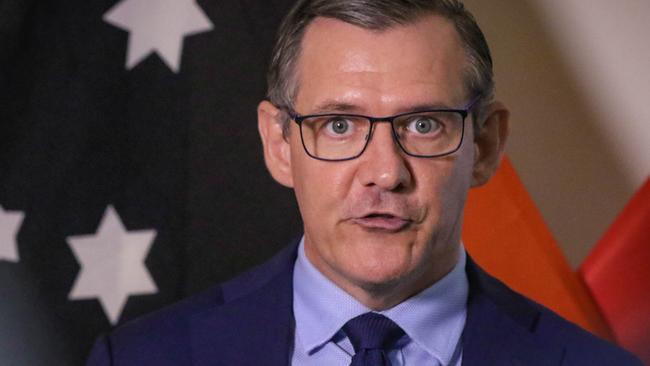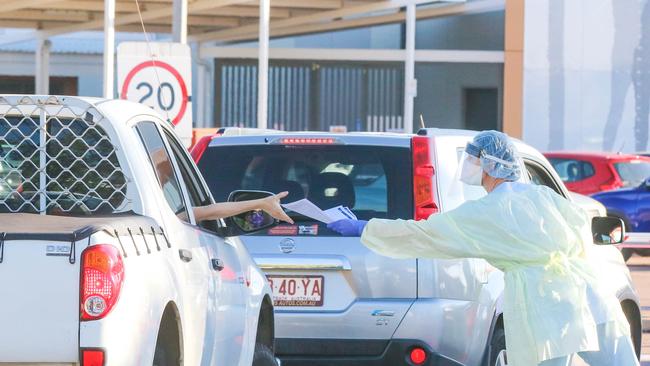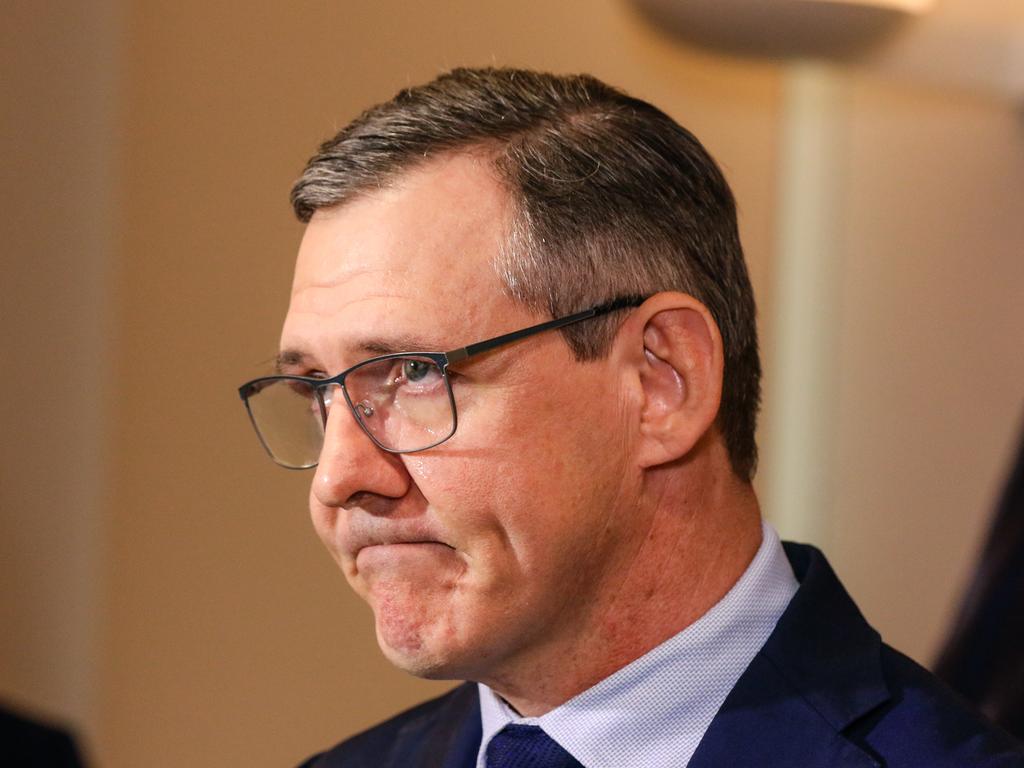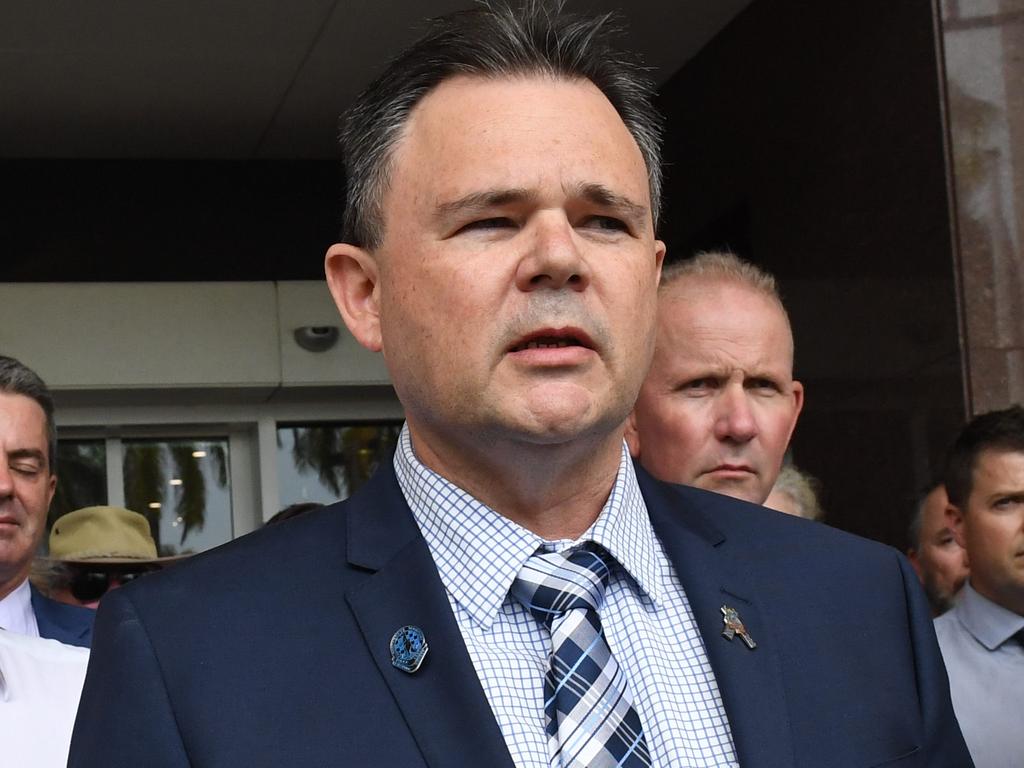NT Chief Minister Michael Gunner announces shock resignation
An emotional NT Chief Minister has announced he is stepping down, making his final act passing the 2022 budget.

Michael Gunner has announced he is stepping down as the Northern Territory Chief Minister, making his final act passing the 2022 budget.

Mr Gunner told the Northern Territory parliament on Tuesday he would be resigning, with the deputy Chief Minister Nichole Manison taking over.
The surprise announcement came shortly after the birth of Mr Gunner’s second child.
Those close to him have long suggested he would likely resign in the first half of 2022, although his office has been keen to dispel such rumours.
“Handing down this budget is my final act as treasurer and my final act as chief minister,” Mr Gunner told parliament in his 2022-23 budget speech.
He said that after the birth of Nash, his second child with wife and ABC journalist Kristy O’Brien, “my head and my heart are no longer here — they are at home”.
“There is never a perfect time to step back, to walk away, to give others a go,” he said.
“But for me, for my family, this feels like the right time.”
After a teary address, Mr Gunner hugged his deputy, Nicole Manison, who will become acting Chief Minister until a new Labor leader is chosen.
Mr Gunner led Labor to victory amid the collapse of the former Giles Country Liberal Party at an election in 2016. He was returned in 2020, helping Labor to a second term.
His resignation will trigger a leadership contest under complex Labor Party rules.
Health Minister Natasha Fyles and Energy Minister Eva Lawler have been touted as possible replacements among Labor Party supporters. Ms Manison is also viewed favourably but has a young family, and it remains unclear if she would want the top job.
Inflation and GST windfall boost NT coffers
Only moments before Mr Gunner had handed down his government’s 2022-23 fiscal and economic outlook forecasting an $854 million deficit for this financial year, down from $1.36 billion forecast last financial year, and $1.1 billion deficit next financial year, down from $1.2 billion forecast in 2021-22.
The improvements were mandated by a significant uplift in the national GST pool “attributable to improved economic expectations and the effect of national inflation”.
Labor’s policy changes since the 2021-22 budget added a net negative $321 million to this year’s fiscal balance and between $155 million and $185 million per year over the forward estimates.
But the government’s projections were bailed out by an average uplift in GST revenue of 14.9 per cent per year over the forecasting period.
Mr Gunner said, “despite the extraordinary pressures placed on the budget in recent years, from construction downturn to increased demand for government services, and the fiscal hit from COVID-19, despite all those pressures, the budget position is better this year”.
“Importantly, we can now forecast a government net operating surplus in 2024. This would be the first operating surplus in nearly a decade,” he said.
“As well as the strict fiscal discipline measures delivered by our governing in the last few years, the budget is benefiting from a better-than-expected economic recovery, both in the Territory and throughout Australia.”
Net debt will continue to grow from $7.7 billion this financial year to $8.7 billion in 2022-23 and over $9 billion in subsequent years because even though if the government achieves an operating surplus in 2024, it will no longer be borrowing to pay everyday expenses, it will still be borrowing to fund infrastructure comments.

“While our spending stays under control, the strong economic recovery is boosting the Territory’s own taxation revenues, as well as our GST revenue. Both are now much stronger than first forecast,” Mr Gunner said.
“Our projections of GST revenue in the coming years are not the same as the commonwealth’s projections. In fact, ours are lower. If we had used their projections in our budget, the bottom line would show an earlier return to surplus. More optimistic revenues would, of course, be most welcome, but we are not banking on that to get us to balance. The Territory’s path to budget surplus is clear, credible and achievable.”
By far, the Territory’s largest revenue source is commonwealth grants and GST payments. Its biggest expense is public sector wages. Territory-funded expenses were projected to decline by 2.8 per cent to 2025-26 compared to a 9.3 per cent forecast increase in own-source revenue. But the success of that restraint depends on individual agencies sticking to a wages freeze to 2024–25, followed by a 2 per cent cap on growth.
“The budget is on the right track, and we must keep it on the right track,” Mr Gunner said.
“An important part of that is the public sector wages policy … the revenue improvements in this budget are better than previously forecast. If we can lock these in, and continue to make gains in future budgets, then hopefully the current wages policy is something that could be revisited.”
Territory State Final Demand was forecast to grow by 8.8 per cent this financial year, more than double what was forecast in last year’s budget, and by 5.4 per cent in 2022-23.
“A substantial part of the elevated business investment we are currently seeing comes from the Santos Barossa construction project,” Mr Gunner said.

“Our economic figures also do not include the commonwealth’s massive $2.6 billion investment in economy-growing infrastructure in the Territory, announced in its recent budget.”
Treasury estimates inflation in the NT at 5.7 per cent in 2021-22, falling to 3.1 per cent in 2022-23. Risks to economic forecasts include coronavirus mutations and the flow-on effects of the Russia-Ukraine conflict.
The budget included a $3.2 billion infrastructure program, of which $2.4 billion was carried over from previous financial years and $1.7 billion in new money committed for 2022-23.
Budget papers showed remote infrastructure programs were significantly affected by the coronavirus pandemic, with over $1.3 billion in transport infrastructure spending to be carried over from 2021-22 and almost $700 million worth of remote housing and other regional infrastructure projects also incomplete.








To join the conversation, please log in. Don't have an account? Register
Join the conversation, you are commenting as Logout